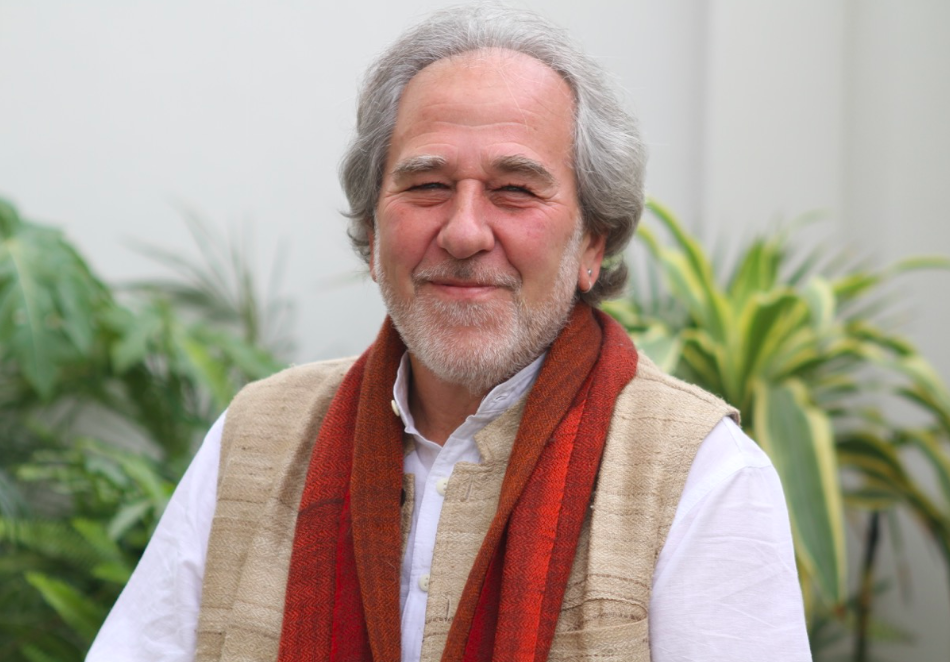The cover star of our Summer 2021 issue was the one and only Bruce Lipton! He spoke to us about how we can begin to perceive – and thereby create – heaven on earth, and why the current changes in society mirror a caterpillar’s process of transformation. The butterfly awaits.
Believe in Heaven on Earth
We interview Bruce Lipton
by Aisling Cronin
Interviewers: Paul Congdon and Jane Stephenson
Bruce H. Lipton, PhD, is a man who needs little introduction. He is an internationally recognised leader in bridging science and spirit, whose work has served as an inspiration to many. Bruce is a stem cell biologist, bestselling author of ‘The Biology of Belief’, and recipient of the 2009 Goi Peace Award. He has been a guest speaker on hundreds of TV and radio shows, as well as a keynote presenter for multiple international conferences.
Bruce’s research at Stanford University’s School of Medicine between 1987 and 1992 revealed that the environment – operating through the cell membrane – controlled the behaviour and physiology of cells, turning genes on and off. His discoveries ran counter to the established scientific view that life is controlled by the genes, and they presaged one of today’s most important fields of study: the science of epigenetics. Two major scientific publications derived from these studies defined the molecular pathways connecting the mind and body.
During a recent interview we enjoyed with him, Bruce said of his early years, ‘I was a scientist who was never spiritual, but when I studied cells – and cells revealed their underlying mechanisms to me – it changed my entire life. I realised that there is a mechanism to how spirit actually works inside our bodies.’
We asked Bruce how his scientific views have developed over the years, and he said:
Quantum physics is the most valid science on planet Earth. There is no science with more factual truth than quantum physics. Quantum physics says that the world we’ve been looking at, which is composed of matter, physical things, visible objects: that’s all an illusion. Everything is energy. There’s no such thing as matter.
What do I mean by that? Well, when scientists first started to take cells apart, they found atoms containing a little solar system, with a nucleus at the centre and electrons rotating around them, like little satellites. Then they investigated those subatomic particles and found they were composed of protons and neutrons … but when they took those apart, what did they find? Nothing! They were just energy vortices.
So an atom isn’t made out of matter. It’s made out of energy, and so are we. Quantum physics has recognised this as a fundamental truth since it was founded in 1927. Max Planck said, ‘All matter originates and exists only by virtue of a force … We must assume behind this force the existence of a conscious and intelligent Mind. This Mind is the matrix of all matter.’
This shows us, very clearly, that our consciousness creates our life experiences. We no longer have to view ourselves as passive, or unable to influence our material circumstances. We are not victims of what’s happening.
For a long time, this has been the template of our understanding: our genes control our traits. We did not pick the genes we were born with. We cannot change the genes if we don’t like our traits. Genes turn on and off by themselves. But the science of epigenetics explores a reality that goes deeper than that.
This comment led us into a discussion about what the science of epigenetics is.
The word ‘epi’ means ‘above’. For example, you’d refer to the skin as the epidermis, because it sits above another layer in our bodies called the dermis. So the science of epigenetics refers to what sits above genetic control. And what’s above the genes? The environment. Contrary to our prior belief, genes don’t randomly turn on and off by themselves. They are controlled by the environment in which they live.
The way I describe it is: genes are blueprints that are used to create proteins, the building blocks of the body. In a lab, the growth of genetically identical cells can be observed in petri dishes, and it has been proven that these cells – identical as they are, in their genetic makeup – will develop differently, based on the culture medium in each petri dish. And we are all skin-covered petri dishes! Our blood, in fact, is the culture medium that feeds every one of our cells.
So what elements go into a successful culture medium? Firstly, good nutrition. Secondly, cellular signals, which would include hormones, emotional chemicals, and other factors that contribute to our overall physiological makeup. And what influences those factors? External and internal signals. These include physical observations we make about our surroundings. Is it cold outside? Is it warm? What’s the weather like? These are the signals that the brain receives and communicates to the rest of our body.
But here’s the key thing: our mind comes in and interprets those signals. Two people can be in the exact same place, and one person might think, ‘this is the most beautiful place I’ve ever been in’, while the other person could be thinking, ‘this place is scary.’ Even though those people are in exactly the same surroundings, or seeing the exact same thing, their experience of that thing is totally different. Each one of us perceives our environment through the lens of our mind, our experiences, our worldview.
So why is that relevant? Because the mind sends signals to the nervous system, which then controls your genes. Epigenetics! This is exactly what has been discovered by quantum physics, and this is why I describe this entire mechanism as the biology of belief.
When you’re in love, your culture medium will reflect that. Your blood will contain all of the chemicals associated with love: dopamine, oxytocin, vasopressin and growth hormones, which make you feel vital and healthy and radiant. That’s why people in love will often be told that they look as though they’re glowing.
Someone who’s in a lot of fear, however, will have a different chemical makeup in their blood: stress hormones, cortisol, cytokines, histamine. Fear chemistry shuts off the immune system. The more afraid you are, the less effective your immune system is – and this doesn’t happen to ‘punish’ you. It happens simply because the immune system uses a lot of energy.
If you’re being chased by a sabre-toothed tiger, you need all of the energy you can get to run away from that tiger. The body wants to respond to the immediate threat. So it decides, in that moment, that the tiger is a bigger emergency than, say, a bacterial infection you might have.
So your thoughts are not just passing through. They are directly influencing the culture medium that houses your cells.
We also inherit thoughts and beliefs from people around us: our parents, our families, our friends, wider society … and it is important for us to understand that sometimes, the ‘programmes’ we inherit don’t support what we truly wish to create in life.
Bruce then delved into the specific tools we can use to rewrite our subconscious programmes.
Energy psychology is one way to ‘rewrite’ those programmes and become more conscious of what you’re thinking and saying. Another way to do this is hypnosis. Anther way is habituation. Repeat the habit you want to acquire, or your affirmations, over and over again. Practise and practise until the new way of life has become second nature to you. Sometimes this is a case of ‘fake it ’til you make it.’
We hear a lot about the placebo effect, which is a term science uses to describe how the conscious mind creates healing within the physical body, using a sugar pill. We know that positive thinking and the placebo effect can heal you.
So we have to take responsibility for our thinking. We may not be able to change our genes, but we can change our programmes. We can change how we think. Find something that you love doing, and let all of your love, and all of your conscious attention, be focused on that thing. Invest your energy in things that bring you joy. Live your days in a state of love. Heaven on Earth can be experienced every single day of your life, if you are willing to see it.

We asked Bruce how he feels about the societal transformation that is currently underway on our planet. He described our collective experience using a beautiful metaphor of a caterpillar transforming into a butterfly:
This is a very interesting time, when the world seems to be turning upside down and there’s chaos all over … but what’s so interesting, from a biological point of view, is that we’re in exactly the right place we need to be. In the history of this planet, there have been five mass extinctions. Human behaviour is driving the sixth mass extinction, so we now have to profoundly change how we’re living.
A very simple analogy I like to use is how a caterpillar changes into a butterfly. A caterpillar is an incredibly voracious organism. Put it on a plant, and it’ll eat all the leaves on that plant. But at a certain point, the caterpillar stops growing, puts itself into a cocoon, and transforms into a butterfly. A butterfly is a very light-touch organism, compared to the caterpillar, which is an incredibly voracious organism.
The cells are the living organism that determine how that caterpillar – or how any of us – will manage that transformation. So if you look at me, for example, you might say, ‘oh, there’s Bruce, he’s a living organism’, but I’d say, ‘no, Bruce is actually a community of fifty trillion cells, and they are the living organisms’. Back to the story of the caterpillar: the caterpillar is composed of billions of cells. All of these cells are doing specific jobs – as part of the nervous system, digestive system or circulatory system, for example – and as long as they are doing their jobs, everything is flowing smoothly.
However, when the caterpillar stops moving and prepares to go into its cocoon, suddenly there are no more jobs. Everything is breaking down, the caterpillar is disintegrating, and all at once, you’re left with a soup of cells that are all out of work! But within that community, you have what are called ‘imaginal cells’, and they’re the ones with the vision of the butterfly. They’re the ones who co-ordinate the mass of unemployed cells and ‘retrain’ them, in a sense, to make the butterfly.
So how is this relevant? Our civilisation has become a voracious caterpillar. That’s where our problems have come from. We’ve damaged the environment to an extent that we’re being forced by the planet to transform how we live. So now, we need to create a more sustainable ‘butterfly’ version of our civilisation.
You can choose to look at the caterpillar version of our civilisation, and get upset about how it is falling apart … or you could look in the other direction and get inspired by how we are building something new. The civilisation that’s coming down has to come down. How else do we move from where we are today to a more beautiful, sustainable, ‘light touch’ civilisation? If you’re holding onto the caterpillar version of life, I would have to say, ‘I’m sorry. It’s not going to work anymore. Let it go.’
Learn more about Bruce and his works at: brucelipton.com


